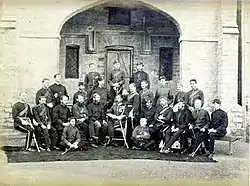Hugh Rowlands
General Sir Hugh Rowlands VC KCB DL (6 May 1828 – 1 August 1909) was a Welsh recipient of the Victoria Cross for courageous action that led to the rescue of Colonel William O'Grady Haly during the Crimean War.[1]
Sir Hugh Rowlands | |
|---|---|
 Sir Hugh Rowland's grave in Llanrug | |
| Born | 6 May 1828 Llanrug, Wales |
| Died | 1 August 1909 (aged 81) Llanrug |
| Buried | St Michael's Churchyard, Llanrug |
| Allegiance | |
| Service/ | |
| Rank | General |
| Unit | 41st (Welsh) Regiment of Foot 34th Regiment of Foot |
| Battles/wars | Crimean War Anglo-Zulu War |
| Awards | Victoria Cross Knight Commander of the Order of the Bath Légion d'honneur (France) Order of the Medjidieh (Ottoman Empire) |
Details
Hugh Rowlands was the second son of minor Welsh landowner John Rowlands and his wife Elizabeth (née Hartwell) of Plas Tirion, Llanrug, and claimed descent from Bleddyn ap Cynfyn, Prince of Powys, and Dafydd ap Llywelyn, Prince of Gwynedd. He was educated at Beaumaris Grammar School and Mr John Taylor's Cramming Academy, Woolwich.
Rowlands was 26 years old, and a captain in the 41st (Welsh) Regiment of Foot, British Army during the Crimean War. He first saw action at the battle of the Alma in September 1854 and was present at Little Inkerman the following month.
On 5 November 1854 in the Crimea at Inkerman, Captain Rowlands and Private John McDermond rescued Colonel William O'Grady Haly of the 47th Regiment who had been wounded and surrounded by Russian soldiers. He also acted with great gallantry in holding the ground occupied by his advanced picquet against the enemy at the commencement of the Battle of Inkerman. For this action he became the first Welshman to be awarded the Victoria Cross.
He further distinguished himself during the siege of Sevastopol and was nominated for a Victoria Cross in recognition of his action during the second assault on the Redan in September 1855.[2]
After service in the West Indies and India he was a Special Service officer in South Africa in 1878 and 1879. He was appointed Commandant of the Transvaal in 1878 and led an unsuccessful assault on the Pedi stronghold of Chief Sekukuni. He served as a brigadier-general during the later stages of the Zulu War.
His latter years of service were spent in India where he commanded the Bangalore Division of the Madras Army and, on two occasions, took temporary command of the Madras Army. Returning to Britain he was appointed Lieutenant of the Tower of London in 1893 and Commander-in-Chief, Scotland in 1894 before retiring in 1896.[3]
In 1897 he was appointed Colonel of the Duke of Wellington's Regiment, which he retained until his death in 1909.[4]
Further information
He later achieved the rank of General. He was born and died in Llanrug. His VC is on display at the Welch Regiment Museum in Cardiff Castle in Wales. He served as a deputy lieutenant of Caernarfonshire and was a justice of the peace in Caernarfonshire and in the Transvaal. His only son, Major Hugh Barrow Rowlands, Suffolk Regiment and King's African Rifles, died of wounds in Somaliland in 1903.

References
- http://www.vconline.org.uk/sir-hugh-rowlands-vc/4588105633
- "No. 21971". The London Gazette. 24 February 1857. p. 659.
- "Hugh Rowlands". National Library of Wales. Retrieved 29 November 2014.
- Duke of Wellington's regimental website, Colonels of The Regiment Archived 4 March 2016 at the Wayback Machine
Further reading
- Monuments to Courage (David Harvey, 1999)
- The Register of the Victoria Cross (This England, 1997)
- Rowlands, VC - the life and career of General Sir Hugh Rowlands, VC, KCB (W. Alister Williams)
- Commandant of the Transvaal - the life and career of General Sir Hugh Rowlands, VC, KCB (W. Alister Williams)
- Heart of a Dragon, the VCs of Wales and the Welsh Regiments Vol 1, 1854-1902]] (W. Alister Williams)
External links
- Location of grave and VC medal (Gwynedd, Wales)
| Military offices | ||
|---|---|---|
| Preceded by Arthur Lyon Fremantle |
GOC Scottish District 1894–1896 |
Succeeded by Edward Chapman |